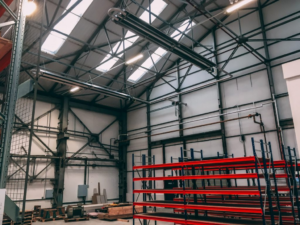5 Factors to Consider for Comfort Heating in Commercial Warehouses
Last updated on December 12th, 2022 at 12:49 am
 Comfort heating is an essential application in commercial settings, especially warehouses where staff frequent. Choosing a heating unit that efficiently heats your space without costing too much or potentially posing a safety hazard is also crucial. This post will examine the factors warehouse owners should consider before choosing an industrial heater for their comfort heating needs.
Comfort heating is an essential application in commercial settings, especially warehouses where staff frequent. Choosing a heating unit that efficiently heats your space without costing too much or potentially posing a safety hazard is also crucial. This post will examine the factors warehouse owners should consider before choosing an industrial heater for their comfort heating needs.
1. Design of the warehouse facility
Some warehouse facilities face constant issues with heating. Employees complain about feeling cold regularly, and the costs of keeping them warm become astronomical. And, of course, the opposite is true too.-Some warehouse facilities don’t seem to have any troubles with heating efficiency.
In many of these cases, the design of the warehouse itself is the cause. Depending on factors such as ventilation systems, window type and placement, and roof design (i.e. destratification), some facilities are much harder to keep warm, while others require less effort.
When selecting an industrial heater, it’s essential to examine the design of your warehouse. Pay attention to factors such as:
- Wall insulation
- Door materials, and operation (i.e., high-speed doors close quicker, and therefore, retain more heat)
- Ceiling fans
- Ceiling height (higher ceilings allow heat to rise, meaning staff will be colder)
If you notice many factors that make heating difficult, you may need to install an industrial heater that can produce a greater thermal output. Of course, it also helps to improve other features as well, such as adding insulation.
2. Climate zones present in the facility
Climate zones are a staple consideration in all commercial warehouses. Unsurprisingly, different rooms and facilities in a warehouse will need different temperature settings. The temperature in an office will differ from the warehouse floor and storage unit.
When considering climate zones, you’ll likely need to install heaters directly suitable to the zone to which they’re directing warm air. Generally speaking, you’ll need a greater thermal output for zones along the warehouse’s perimeter and in lobbies, where heat is more likely to escape.
Climate-control heaters and thermostats are necessary since you’ll need to maintain different temperature settings for different climate zones. That said, it’s important to choose industrial heaters capable of producing a wide range of temperatures.
3. Size of the heating unit itself and its output
Of course, the heater’s capacity is a significant deciding factor when choosing a unit for warehouse comfort heating. The industrial heater of choice must suit the needs of your warehouse employees and the climate zones in which they work.
Once those considerations have been made, you can choose your industrial heater. Naturally, the heater configurations need to provide the thermal output you need for your warehouse.
Industrial heating configurations to consider
- Size of the heater: Too big runs more and wastes energy, whereas a heater that’s too small doesn’t provide enough heat.
- Watt density: The measure of power from a heating element divided by its surface area. A higher or lower watt density will be ideal depending on your heating needs.
- Wattage: The electrical output needed to generate the required heat efficiently.
- Orientation: Placing the heater in specific locations can optimize (or diminish) the flow of heat and the amount provided.
- Method of heating: There are different ways to heat a warehouse space, including traditional, direct-heating, and more modern radiant heating. The most effective approach depends on cost, efficiency, and warehouse space.
Pre-built heaters may be available to suit your needs. However, it’s common for warehouse managers to need customized solutions to meet their heating needs.
4. Distribution path of heated air
Warehouse managers often overlook a crucial factor when optimizing their heating—air distribution. It’s easy to forget about basic thermodynamic principles and their effects on temperature, even though they strongly influence comfort heating in warehouses.
Modern facilities often feature wide, open, and high-ceiling interior designs. As trendy as this aesthetic is, it’s not conducive to comfort heat. After all, heat rises, so such high and open spaces can leave employees feeling cold.
That’s why it’s crucial to place industrial heaters in locations that offer more direct heating to employees (without overheating them). That may be closer to the ground level since overhead heating might be insufficient in a vast space. Ultimately, the best place to install your heater will depend on your warehouse design.
5. Ventilation in the facility
Closely related to distribution is the factor of ventilation. The overall ventilation in your warehouse space can profoundly affect the temperature of your warehouse space. For example, obstructions, debris, and other ventilation problems can block the flow of heated air.
Conversely, some of those obstructions can lead to overheating and damage to the heater. That’s why managers must assess the quality of their building’s ventilation. Only when it’s deemed efficient should installing an industrial heater commence.
Find your heating comfort zone with good planning
You must optimize your warehouse’s heating systems sooner than later. Poor heating, especially during colder months, can drastically impact your employee’s well-being and productivity. Also, you can easily overspend on heating costs with an inefficient system.
Fortunately, with some assessments of your needs, you can figure out your warehouse heating needs and meet them with an industrial heater. Here at Wattco, we offer a wide range of industrial heating units to facilitate your comfort heating needs. That includes pre-constructed and customizable devices to help maximize your warehouse heating.
Get a quote for your industrial heater today. Our representatives will help you find the exact setup needed for your industrial needs.
